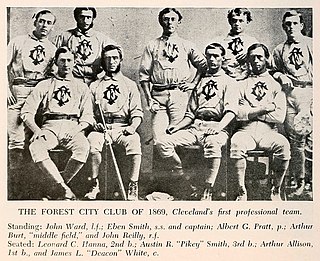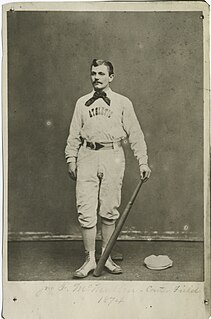
Estevan Enrique "Steve" Bellán, also known as Esteban, was a Cuban-American professional baseball player who played as a third baseman for six seasons in the United States, three in the National Association of Base Ball Players (NABBP) from 1868 to 1870, and three in the National Association of Professional Base Ball Players (NAPBBP) from 1871 to 1873. He is credited as the first Latin American born individual to play professional baseball in the USA.
The National Association of Professional Base Ball Players (NAPBBP), often known simply as the National Association (NA), was the first fully-professional sports league in baseball. The NA was founded in 1871 and continued through the 1875 season. It succeeded and incorporated several professional clubs from the previous National Association of Base Ball Players (NABBP) of 1857–1870, sometimes called "the amateur Association". In turn, several NA clubs created the succeeding National League of Professional Baseball Clubs, which joined with the American League of Professional Base Ball Clubs to form Major League Baseball (MLB) in 1903.
The Cincinnati Red Stockings of 1869 were baseball's first openly all-professional team, with ten salaried players. The Cincinnati Base Ball Club formed in 1866 and fielded competitive teams in the National Association of Base Ball Players (NABBP) 1867–1870, a time of a transition that ambitious Cincinnati businessmen and English-born ballplayer Harry Wright shaped as much as anyone. Major League Baseball recognized those events officially by sponsoring a centennial of professional baseball in 1969.

William Henry "Harry" Wright was an English-born American professional baseball player, manager, and developer. He assembled, managed, and played center field for baseball's first fully professional team, the 1869 Cincinnati Red Stockings. He is credited with introducing innovations such as backing up infield plays from the outfield and shifting defensive alignments based on hitters' tendencies. For his contributions as a manager and developer of the game, he was inducted into the Baseball Hall of Fame in 1953 by the Veterans Committee. Wright was also the first to make baseball into a business by paying his players up to seven times the pay of the average working man.

Douglas L. Allison was an American Major League Baseball player. He began his career as a catcher for the original Cincinnati Red Stockings, the first fully professional baseball team. Allison was one of the first catchers to stand directly behind the batter, as a means to prevent baserunners from stealing bases. He was considered a specialist, at a time when some of the better batsmen who manned the position normally rested, or substituted at other fielding positions. Allison became the earliest known player to use a type of baseball glove when he donned buckskin mittens to protect his hands in 1870.
The National Association of Base Ball Players (NABBP) was the first organization governing American baseball.
The following are the baseball events of the year 1871 throughout the world.
The following are the baseball events of the year 1870 throughout the world.

The Troy Trojans were a Major League Baseball team in the National League for four seasons from 1879 to 1882. Their home games were played at Putnam Grounds (1879) and Haymakers' Grounds (1880–1881) in the upstate New York city of Troy, and at Troy Ball Clubs Grounds (1882) across the Hudson in Watervliet, or "West Troy" as it was known at the time.
Eckford of Brooklyn, or simply Eckford, was an American baseball club from 1855 to 1872. When the Union Grounds opened on May 15, 1862 for baseball in Williamsburg, Brooklyn, it became the first enclosed baseball grounds in America. Three clubs called the field on the corner of Marcy Avenue and Rutledge Street home; however, the Eckford of Brooklyn were the most famous tenant. They played more games than any other club that year (7) and won the "national" championship, repeating the feat in 1863. During that two year period, the Eckfords won 22 straight matches which was the longest undefeated and untied streak to date. In the late 1860s, they were one of the pioneering professional clubs, although probably second to Mutual of New York at the home park. In its final season, Eckford entered the second championship of the National Association, the first professional baseball league in America, so it is considered a major league club by those who count the NA as a major league.
James Henry Foran was an American Major League Baseball player from Pennsylvania, and a participant in the first game ever played in a professional baseball league, between his Fort Wayne Kekiongas and the Cleveland Forest Citys on May 4, 1871. Foran had one single in four at-bats, one of only four hits Ft. Wayne had that day; nonetheless, the Kekiongas won, 2-0.

The Forest Citys were a short lived professional baseball team based in Cleveland in the early 1870s. The actual name of the team, as shown in standings, was Forest City, not "Cleveland". The name "Forest Citys" was used in the same generic style of the day in which the team from Chicago was called the "Chicagos". Modern writers often refer to the club as the "Cleveland Forest Citys", which does not reflect 1870s usage, but does distinguish the team from the Rockford, Illinois, professional team that was also called "Forest City".
The Middletown Mansfields were an early baseball team in Middletown, Connecticut that existed from 1866 to 1872.

The Olympic Club of Washington, D.C., or Washington Olympics in modern nomenclature, was an early professional baseball team.

George Zettlein was a professional baseball pitcher. He played six seasons in Major League Baseball from 1871–76 for the Chicago White Stockings, Troy Haymakers, Brooklyn Eckfords, Philadelphia White Stockings of the National Association (NA), and Athletic of Philadelphia in the National League.

Alfred W. "Count" Gedney, was an American professional baseball player. During four seasons in the National Association of Professional Base Ball Players, 1872 to 1875, he played left field for four teams, the Troy Haymakers, Brooklyn Eckfords, New York Mutuals, and Philadelphia Athletics.

Charles Hodes was an American professional baseball player who played as a catcher, infielder, and outfielder in the National Association for three seasons from 1871 to 1874. A Brooklyn native, Hodes played one season each for the Chicago White Stockings, Troy Haymakers, and Brooklyn Atlantics. He had a career batting average of .231 in 63 total games before dying from tuberculosis in 1875.

John F. McMullin was an American professional baseball player. During the first professional league season in 1871, he was the only regular left-handed pitcher, while in later seasons he mainly played the outfield. After playing almost every game throughout the five National Association seasons (1871–1875), he did not play a single game in the National League that succeeded it. He died in his native Philadelphia five years later, only 32 years old.

Charles Richard "Dickie" Flowers was an American professional baseball player in the National Association. He was a shortstop for the 1871 Troy Haymakers and the 1872 Philadelphia Athletics. Previously, he participated in the first professional season as every-day shortstop for the Keystone club of Philadelphia in 1869, his second season with that team.

Stephen F. King was an American professional baseball player who played in the National Association as a left fielder for the 1871–1872 Troy Haymakers. He was 5' 9" and weighed 175 lb.













